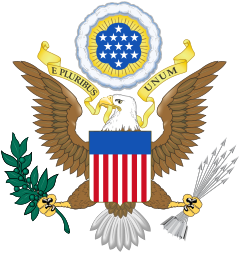Article Seven of the United States Constitution
Article Seven of the United States Constitution sets the number of state ratifications necessary in order for the Constitution to take effect and prescribes the method through which the states may ratify it. Under the terms of Article VII, constitutional ratification conventions were held in each of the thirteen states, with the ratification of nine states required for the Constitution to take effect. Delaware was the first state to ratify the Constitution, doing so on December 7, 1787. On June 21, 1788, New Hampshire became the ninth state to ratify the Constitution, ensuring that the Constitution would take effect. Rhode Island was the last state to ratify the Constitution under Article VII, doing so on May 29, 1790.
| Wikisource has original text related to this article: |
| This article is part of a series on the |
| Constitution of the United States |
|---|
 |
| Preamble and Articles |
| Amendments to the Constitution |
|
|
| Unratified Amendments |
| History |
| Full text |
|

Text
The Ratification of the Conventions of nine States, shall be sufficient for the Establishment of this Constitution between the States so ratifying the Same.[1]
Background
On September 20, 1787, three days after its adoption by the Constitutional Convention, the drafted Constitution was submitted to the Congress of the Confederation for its endorsement. After eight days of debate, the opposing sides came to the first of many compromises that would define the ratification process. The Confederation Congress voted to release the proposed Constitution to the states for their consideration, but neither endorsed nor opposed its ratification.[2]
Ratification
The Constitution was ratified by the 13 states between December 7, 1787 and May 29, 1790 as follows:[3]
| State and date | Votes | PCT | ||
|---|---|---|---|---|
| Yea | Nay | |||
| 1 | Delaware – December 7, 1787 | 30 | 0 | 100% |
| 2 | Pennsylvania – December 12, 1787 | 46 | 23 | 67% |
| 3 | New Jersey – December 18, 1787 | 38 | 0 | 100% |
| 4 | Georgia – January 2, 1788 | 26 | 0 | 100% |
| 5 | Connecticut – January 9, 1788 | 128 | 40 | 76% |
| 6 | Massachusetts – February 6, 1788 | 187 | 168 | 53% |
| 7 | Maryland – April 28, 1788 | 63 | 11 | 85% |
| 8 | South Carolina – May 23, 1788 | 149 | 73 | 67% |
| 9 | New Hampshire – June 21, 1788 | 57 | 47 | 55% |
| 10 | Virginia – June 25, 1788 | 89 | 79 | 53% |
| 11 | New York – July 26, 1788 | 30 | 27 | 53% |
| 12 | North Carolina – November 21, 1789 | 194 | 77 | 72% |
| 13 | Rhode Island – May 29, 1790 | 34 | 32 | 52% |
| Total: | 1071 | 577 | 65% | |
Implementation
In 1787 and 1788, following the Constitutional Convention, a great debate took place throughout the United States over the Constitution that had been proposed. The supporters of the Constitution began the ratification campaign in those states where there was little or no controversy, postponing until later the more difficult ones.
On June 21, 1788, New Hampshire became the ninth state to ratify the Constitution, thus establishing it as the new framework of governance for the United States. Though officially enacted, four states, Virginia, New York, North Carolina and Rhode Island remained outside the new government. The Congress of the Confederation chose March 4, 1789 as the day "for commencing proceedings under the Constitution."[4] Virginia and New York ratified the Constitution before the members of the new Congress assembled on the appointed day to bring the new government into operation.
After twelve amendments, including the ten in the Bill of Rights, were sent to the states in June 1789, North Carolina ratified the Constitution. Finally, Rhode Island, after having rejected the Constitution in a March 1788 referendum, called a ratifying convention in 1790. Faced with the threat of being treated as a foreign government, it ratified the Constitution by the narrowest margin (two votes).[5]
See also
External links
- Gary Lawson & Guy Seidman, When Did the Constitution become Law, 77Notre Dame L. Rev.1 (2001)
- Steve Mount, The Federalists and Anti-Federalists, usconstitution.net (2003)
References
- "Article VII, Ratification". Cornell University Law School. Retrieved November 4, 2016.
- "The Six Stages of Ratification - Teaching American History".
- "The States and the Ratification Process". Center for the Study of the American Constitution, University of Wisconsin–Madison Department of History.
- "Article VII. Ratification". Justia.
- "Observing Constitution Day". National Archives. August 15, 2016. Retrieved November 14, 2018.